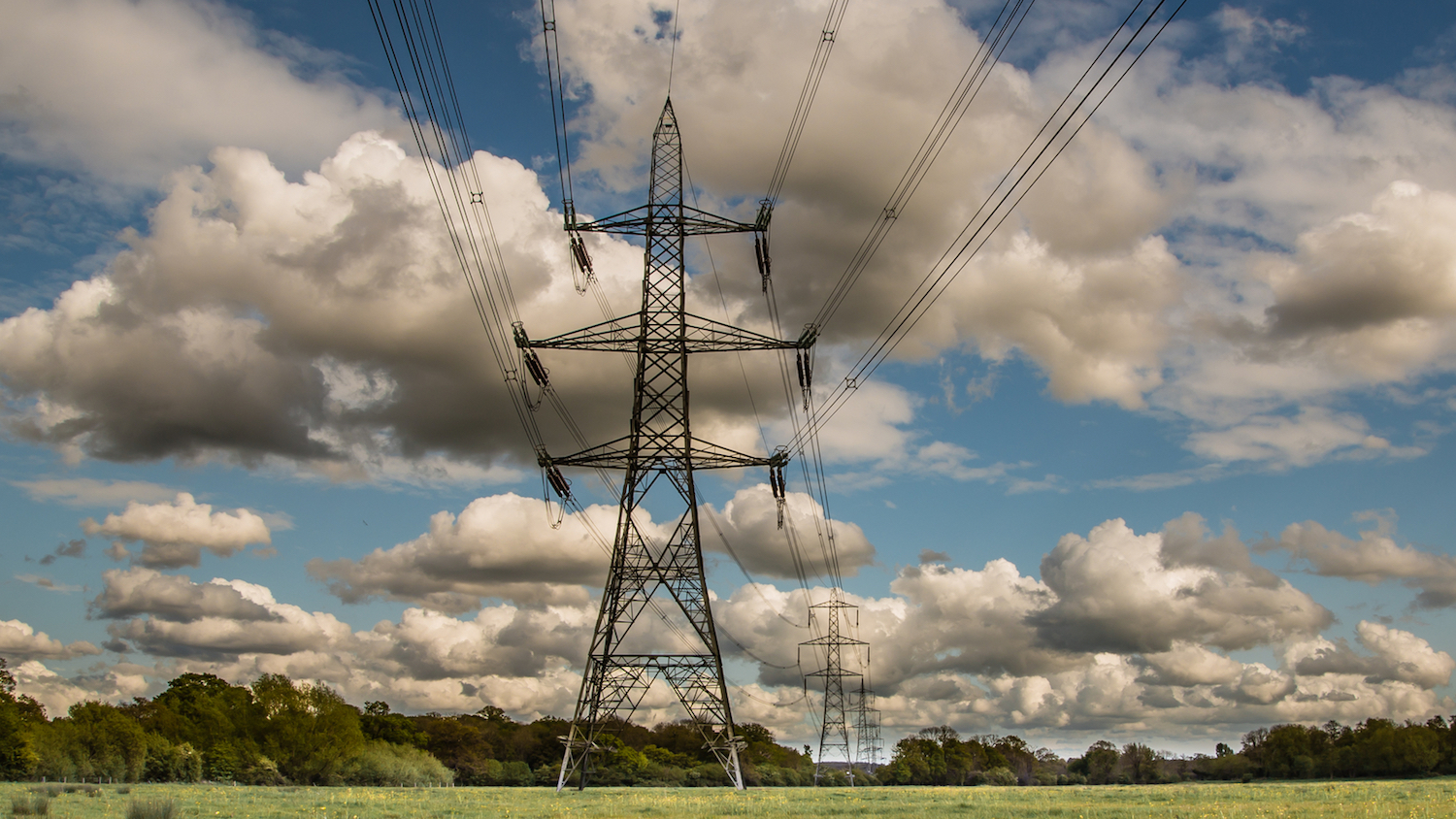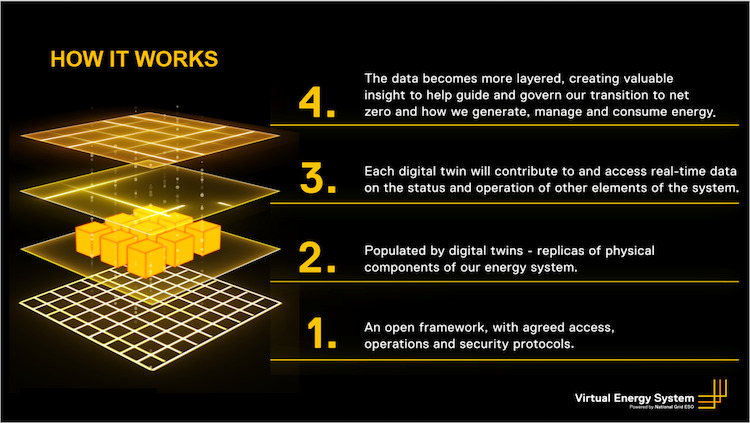
National Grid ESO is building a digital replica of the entire British energy landscape. Carolina Tortora, head of innovation strategy and digital transformation at National Grid ESO, explains to Denise Chevin how this so-called Virtual Energy System (VirtualES) will create a virtual environment to share data, model and predict scenarios that will support decarbonisation and how they plan to develop it.
BIMplus: It sounds a hugely ambitious project, can you explain briefly what benefits it will bring?
Carolina Tortora: The VirtualES will be a digital replica of Great Britain’s entire energy landscape. This ecosystem will comprise individual digital twins, securely sharing information to model the entire system, drive innovation, advance sustainability progress and support better outcomes for business, the environment, and society. All without the need to make expensive changes to the physical grid.
Acting as a test-track, this unified, real-time view of every part of the energy system will allow the industry to connect various digital twins that simulate connected assets and different parts of the network across Great Britain.
This virtual environment will then enable users to model new scenarios, measure the impact across different parts of the system, test innovation, and drive cost efficiencies while supporting the decarbonisation of our energy industry and the transition to net zero.
Specific benefits include:
- the ability to optimise the whole energy system operation, including the connection with the National Digital Twin programme;
- improving access to real-time data to aid decision-making when balancing supply and demand;
- supporting the planning and operation of new infrastructure and assets;
- accelerating innovation, the introduction of renewable energy and the route to net zero; and
- ultimately, reducing costs for consumers.
While this complex programme is being driven by National Grid ESO, the Virtual Energy System will be created and owned by the industry, for the industry. Cross-collaboration will be crucial to realising this vision and we are already working with several partners to turn this vision into a reality.
Is the intention that it will cover absolutely everything – the transmission lines, distribution lines, power substations?

“The twin, just like the physical system, will never be fully completed. However, we expect a high level of completeness to be reached within a five-year timeframe.”
The VirtualES will create a decentralised network where each actor, for example a generator, transmission, or distribution network, could develop their own digital twins and then connect and share their data through the VirtualES.
We envisage that VirtualES users will include network companies such as electricity and gas transmission owners, and electricity and gas distribution network owners. In addition, generation asset owners and operators, such as wind farms, solar parks, thermal generators, retail companies, traders, aggregators and ultimately, British consumers. National Grid ESO is supporting several gas projects including the Gas Networks Interoperable Digital Twin.
Because it is so ambitious, where and how do you start?
This type of scale requires the right approach, particularly around access, operations, security protocol and compliance. Earlier this year, National Grid ESO received funding from Ofgem’s Strategic Innovation Fund for the discovery phase of the Common Framework – the development of a ‘blueprint’ of technical standards and engagement principles that stakeholders can follow to ensure it is interoperable for users.
Part of this work includes exploring, with our partners, key areas such as cyber security, data quality, legal and regulatory issues, risks, and metadata among others.
National Grid ESO has been working with a technical consortium (including Arup, the Energy Systems Catapult and Icebreaker One) on the development of that framework to understand what standards should be set out with participants to facilitate collaboration and compatibility. We plan to have this completed by mid-2023. At this point, participant businesses will be able to adopt these principles and actively become a part of the VirtualES.
Does it rely on all the various players (companies) in energy developing their individual digital twins?
Organisations within the energy sector will build their own digital twins. Many electricity and gas networks have already proposed this in their digitalisation strategies. National Grid ESO will support this development by sharing the Common Framework and by working in collaboration with these organisations to best understand their requirements and experience.
And if so, what is the mechanism for driving that, i.e. what is the mechanism for its development?
The Common Framework and technical principles we will complete during the first half of 2023 will enable participant businesses to adopt these principles and become a part of the VirtualES. The agreed framework will provide the minimum scope required for a single component to be recognised and acknowledged as part of the VirtualES. We believe that once the initial pieces are connected, there will be enough added value deriving from the shared data to encourage wider participation.
What stage is the project at now?
“The scale and ambition of the twin has never been attempted before and the main logistical challenge is collaboration with the industry.”
The project‘s discovery phase is now complete, during which initial benefits were evaluated, and a range of key factors were set in the scope of work for the Common Framework. The second stage of the project will focus on the stitching together of a few initial network data frameworks. The objective of this is to explore emerging challenges and high-risk elements of the project. The solutions will be refined further in latter phases.
Is there a timetable in place for completion?
The VirtualES, just like the physical system, will never be fully completed. However, we expect a high level of completeness within a five-year timeframe, following successful completion of the initial innovation stages of the programme. Ultimately, for National Grid ESO, our mission is to make Great Britain’s energy grid carbon-free by 2035 and we are working towards that goal.
The route to market will be through the creation of specific use cases with stakeholders across the energy sector. We already have several test use cases running concurrently alongside the Common Framework development with partners such as Octopus Energy and X (formerly GoogleX).
What are the key logistical challenges making the project a success?
The scale and ambition of the VirtualES has never been attempted before and the main logistical challenge to ensure the success of the programme is collaboration with the industry.
We can only realise the vision for the VirtualES through the participation of the industry itself and the adoption of the VirtualES standards. The system will be managed and maintained as an evolving virtual asset, which matures over time as more components are added. Therefore, the more active users there are contributing to it, the more insightful the data will be to support intelligent decision-making.

What are the technical challenges?
The VirtualES overall will tackle specific technical challenges.
As the energy system becomes more complex, interconnected and dynamic, our existing industry data processes can become outdated and impractical. Our decisions will require multiple sources of data, span more organisations and more countries.
Therefore, the main technical challenge revolves around creating an ecosystem of cyber secure connected digital twins, translated from complex industrial assets, processes and systems as data and models with supporting information management at a huge scale.
The anticipated technical innovations will consist of greater analytical capacity of energy generation, consumption and distribution. We will achieve this through software and technology components that can be re-used and may be either open-source developed for the VirtualES or other recommended packages that are compatible.
Through use of decision-support tools, operators within the market will be better able to serve customers with improved reliability, pricing and response times to incidents.
If it’s over a long term, how will you guarantee funding?
Financing of the VirtualES to date has primarily been sought through regulated innovation funding – both a combination of Network Innovation Allowance and the Strategic Innovation Fund. We will also be engaging additional funding partners as the programme continues to develop.
In early 2023 we will establish advisory working groups with the energy and technology industries, through which funding and financing will be an area of exploration with stakeholders.
Has any country attempted anything comparable, and if so what, if anything, have you learned from that experience?
Other countries have attempted to create high-level models of their energy systems by a single company or entity. But we are proposing that the GB VirtualES is created collaboratively by all energy actors. In that sense, creating this real-time virtual view of the energy system has never been done before.
Since National Grid ESO announced its plan to digitalise the GB energy system, a similar project has been launched in Singapore. And most recently, the EU has announced plans to accelerate the digitalisation of its energy sector to support deep transformation where digitalisation will play a central role in ensuring a sustainable energy future.
Don’t miss out on BIM and digital construction news: sign up to receive the BIMplus newsletter.












